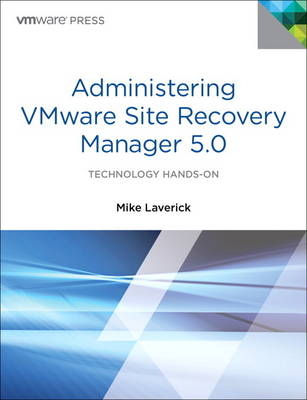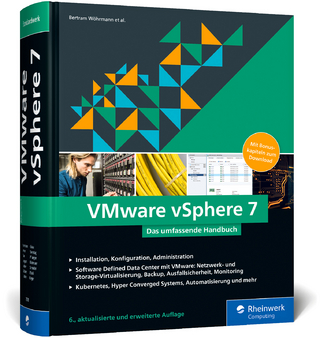
Administering VMware Site Recovery Manager 5.0
VMWare Press (Verlag)
978-0-321-79992-0 (ISBN)
- Titel ist leider vergriffen;
keine Neuauflage - Artikel merken
Administering VMware Site Recovery Manager 5.0 is the complete, technical, hands-on guide to VMware Site Recovery Manager (SRM) 5.0 installation and configuration for experienced VMware professionals.
VMware forum moderator and vExpert Mike Laverick fully explains SRM 5.0’s failover/failback procedures, walks readers through configuring storage replication with hardware from several leading suppliers, and shows how to efficiently implement fast, automated, centralized disaster recovery. Drawing on his extensive experience with SRM and vSphere, Laverick identifies common pitfalls and errors, explains why they occur, and shows exactly how to fix them.
Fully up to date for SRM 5.0, this book delivers “in-the-trenches” technical knowledge you won’t find anywhere else, including expert guidance for utilizing SRM 5.0’s advanced new vSphere Replication (VR).
Coverage includes
Going “under the hood” with SRM 5.0 to thoroughly understand its operation
Configuring SRM 5.0 with Dell EqualLogic Replication, EMC Celerra Replicator, EMC CLARiiON MirrorView, HP StorageWorks P4000 Virtual SAN Appliance with Remote Copy, and NetApp SnapMirror
Configuring multiple LUN/volumes with virtual machines and virtual disks
Installing VMware SRM and configuring vSphere Replication (VR)
Using VR to replicate VMs across locations without third-party storage array-based replication
Using VR to replicate a single VM or groups of VMs to the Recovery Site
Efficiently configuring protected and recovery sites
Using Reprotect Mode to accelerate failback and enhance VM portability
Using dependencies and priority orders to configure SRM based on your existing categories of applications and services
Leveraging SRM 5.0’s scalability improvements to serve large-scale and/or cloud environments
Defining custom recovery plans
Working with alarms, export histories, and access control
Implementing bidirectional relationships and shared site configurations
Scripting automated site recovery
Upgrading from SRM 4.1 to SRM 5.0
Mike Laverick, a former freelance VMware Certified Instructor, is a full-time author/blogger/podcaster/speaker with eighteen years of experience in VMware and related technologies. Now a VMware forum moderator and member of the London VMware User Group, he runs the virtualization website and blog RTFM Education, which publishes free guides and utilities for VMware users. Laverick has been honored with VMware’s vExpert award, assisted Irish and Scottish VMware user groups, and has published several books on VMware technologies.
Preface xv
Acknowledgments xxi
About the Author xxiii
Chapter 1: Introduction to Site Recovery Manager 1
What’s New in Site Recovery Manager 5.0 1
A Brief History of Life before VMware SRM 5
What Is Not a DR Technology? 7
What Is VMware SRM? 10
What about File Level Consistency? 11
Principles of Storage Management and Replication 12
Summary 19
Chapter 2: Getting Started with Dell EqualLogic Replication 21
Creating an EqualLogic iSCSI Volume 23
Granting ESXi Host Access to the EqualLogic iSCSI Volume 26
Enabling Replication for EqualLogic 31
Using EqualLogic Host Integration for VMware Edition (HIT-VE) 39
Summary 42
Chapter 3: Getting Started with EMC Celerra Replication 43
Creating an EMC Celerra iSCSI Target 46
Granting ESX Host Access to the EMC Celerra iSCSI Target 51
Creating a New File System 56
Creating an iSCSI LUN 59
Configuring Celerra Replication 64
Summary 72
Chapter 4: Getting Started with EMC CLARiiON MirrorView 73
Creating a Reserved LUN Pool 75
Creating an EMC LUN 78
Configuring EMC MirrorView 80
Creating a Snapshot for SRM Tests 85
Creating Consistency Groups (Recommended) 88
Granting ESX Host Access to CLARiiON LUNs 90
Using the EMC Virtual Storage Integrator Plug-in (VSI) 93
Summary 95
Chapter 5: Getting Started with the HP StorageWorks P4000 Virtual SAN Appliance with Remote Copy 97
Some Frequently Asked Questions about the HP P4000 VSA 98
Downloading and Uploading the VSA 100
Configuring the VSA (Management Groups, Clusters, and Volumes) 108
Adding ESX Hosts and Allocating Volumes to Them 120
Summary 129
Chapter 6: Getting Started with NetApp SnapMirror 131
Provisioning NetApp NFS Storage for VMware ESXi 133
Creating NetApp Volumes for Fibre Channel and iSCSI 139
Configuring NetApp SnapMirror 147
Introducing the Virtual Storage Console (VSC) 155
Summary 158
Chapter 7: Installing VMware SRM 161
Architecture of the VMware SRM 161
Setting Up the VMware SRM Database with Microsoft SQL Server 2008 180
Installing the VMware SRM Server 186
Summary 199
Chapter 8: Configuring vSphere Replication (Optional) 201
How vSphere Replication Works 201
vSphere Replication Limitations 203
Installing vSphere Replication 205
Enabling and Monitoring vSphere Replication 217
Summary 223
Chapter 9: Configuring the Protected Site 225
Connecting the Protected and Recovery Site SRMs 226
Configuring Inventory Mappings 231
Assigning Placeholder Datastores 237
Configuring Array Managers: An Introduction 241
Creating Protection Groups 257
Failure to Protect a Virtual Machine 262
Summary 267
Chapter 10: Recovery Site Confi guration 269
Creating a Basic Full-Site Recovery Plan 269
Testing Storage Configuration at the Recovery Site 273
Practice Exercise: First Recovery Plan Test 281
Cleaning Up after a Recovery Plan Test 283
Controlling and Troubleshooting Recovery Plans 285
Recovery Plans and the Storage Array Vendors 291
Summary 295
Chapter 11: Custom Recovery Plans 297
Controlling How VMs Power On 299
Adding Additional Steps to a Recovery Plan 309
Configuring IP Address Changes for Recovery Virtual Machines 329
Managing Changes at the Protected Site 337
Multiple Protection Groups and Multiple Recovery Plans 350
The Lost Repair Array Managers Button 354
Summary 354
Chapter 12: Alarms, Exporting History, and Access Control 357
vCenter Linked Mode and Site Recovery Manager 357
Alarms Overview 360
Exporting and History 366
Access Control 368
Summary 372
Chapter 13: Bidirectional Relationships and Shared Site Configurations 375
Configuring Inventory Mappings 376
Refreshing the Array Manager 378
Creating the Protection Group 380
Creating the Recovery Plan 381
Using vApps to Control Start-Up Orders 381
Shared Site Confi gurations 384
Installing VMware SRM with Custom Options to the New Site (Washington DC) 387
Installing VMware SRM Server with Custom Options to the Recovery Site 390
Pairing the Sites Together 392
Decommissioning a Site 394
Summary 394
Chapter 14: Failover and Failback 397
Planned Failover: Protected Site Is Available 400
Unplanned Failover 415
Summary 421
Chapter 15: Scripting Site Recovery 423
Scripted Recovery for a Test 425
Summary 432
Chapter 16: Upgrading from SRM 4.1 to SRM 5.0 433
Upgrading vSphere 435
Upgrading Site Recovery Manager 451
Summary 463
Index 465
| Erscheint lt. Verlag | 12.1.2012 |
|---|---|
| Verlagsort | NJ |
| Sprache | englisch |
| Maße | 228 x 180 mm |
| Gewicht | 830 g |
| Themenwelt | Informatik ► Betriebssysteme / Server ► Virtualisierung |
| Mathematik / Informatik ► Informatik ► Netzwerke | |
| ISBN-10 | 0-321-79992-5 / 0321799925 |
| ISBN-13 | 978-0-321-79992-0 / 9780321799920 |
| Zustand | Neuware |
| Haben Sie eine Frage zum Produkt? |
aus dem Bereich


